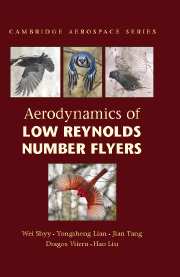3 - Flexible-Wing Aerodynamics
Published online by Cambridge University Press: 05 July 2009
Summary
General Background of Flexible-Wing Flyers
In the development of MAVs, there are three main approaches, which are based on flapping-wings, rotating wings, and fixed wings for generating lift. We focus on the fixed, flexible-wing aerodynamics in this chapter. It is well known that flying animals typically have flexible wings to adapt to the flow environment. Birds have different layers of feathers, all flexible and often connected to each other. Hence, they can adjust the wing planform for a particular flight mode. The flapping modes of bats are more complicated than those of birds. Bats have more than two dozen independently controlled joints in the wing (Swartz, 1997) and highly deforming bones (Swartz et al., 1992) that enable them to fly at either a positive or a negative AoA, to dynamically change wing camber, and to create a complex 3D wing topology to achieve extraordinary flight performance. Bats have compliant thin-membrane surfaces, and their flight is characterized by highly unsteady and 3D wing motions (Figure 3.1). Measurements by Tian et al. (2006) have shown that bats exhibit highly articulated motion, in complete contrast to the relatively simple flapping motion of birds and insects. They have shown that bats can execute a 180° turn in a compact and fast manner: flying in and turning back in the space of less than one half of its wingspan and accomplishing the turn within three wing beats with turn rates exceeding 200°/s.
- Type
- Chapter
- Information
- Aerodynamics of Low Reynolds Number Flyers , pp. 78 - 100Publisher: Cambridge University PressPrint publication year: 2007
- 1
- Cited by



